Koji – the secret behind the good taste of soy sauce and miso
As Buddhist vegetarian cuisine became popular with the general public, people needed to find alternatives that provided the umami flavour associated with meat. This led to the development of dashi, a broth that contains konbu (kelp seaweed) and dried bonito (a kind of fish) flakes. Sometimes dashi is made with shiitake mushrooms as they are also a rich source of umami.
Kelp contains glutamic acids, which are a plant-based umami component, and dried bonito flakes contain inosinic acid, which is an animal-based umami component. In addition, shiitake mushrooms contain the umami component guanosine monophosphate. The combination of dashi with miso and soy sauce has evolved in a uniquely Japanese way since the Kamakura (1185-1333) and Muromachi (1333-1573) periods.
The mold Aspergillus oryzae, which is called Koji in Japanese, is used to break down carbohydrates into sugar during the fermentation of sake and mirin (a kind of sweet, low-alcohol sake used for cooking). The koji strain was improved over time and eventually applied to soybean fermentation.

Koji growing on rice, which is often used as an ingredient to start fermentation in soy sauce and miso production.
In this way, the source of umami was expanded beyond meat dishes by combining dashi with the Japanese flavors of soy sauce and miso imbued with the delicate flavor of soybeans. Over time, the flavour of soy sauce and miso was modified so that they combined well with rice, which is the staple food in Japan and other parts of Asia. In China and on the Korean peninsula, soybeans had been fermented with grains to produce seasonings, but Japan is thought to be the first country to develop a liquid form of soy sauce and to separate out the miso as a separate paste.
The best selling cookbook in the Edo period: a tofu recipe book!
In 1782, a cookbook called “100 Tofu Dishes” was published. It was hugely popular for the amusing way that 100 different dishes using only tofu were introduced, and a sequel was published the following year. Apparently, the book was written for amusement by a man of letters, rather than by an actual chef, and it includes comments on the experience of eating the dishes, which may be another reason why it became a bestseller. A summary of the cooking techniques shows that 55 of the dishes are simmered, 20 are grilled, and 16 are fried. While 44 dishes are prepared with soy sauce and 18 with miso. This suggests that the technique of simmering dishes with soy sauce had been perfected around this time. The book also contained several recipes for dengaku (miso-glazed vegetables), possibly because there were traditional dengaku specialties all over Japan.
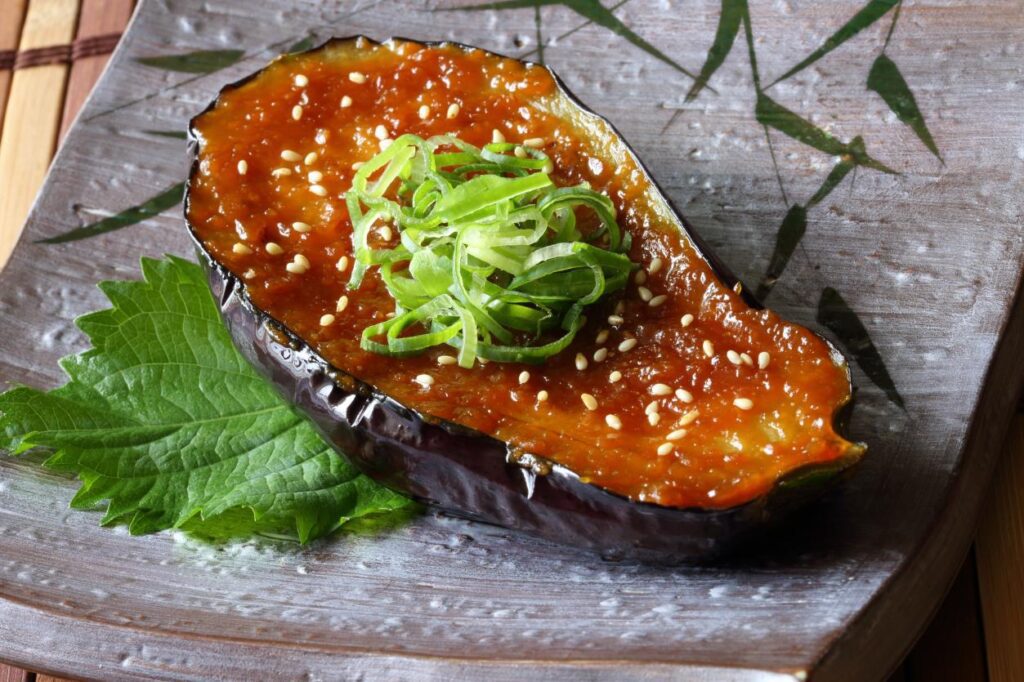
“nasu-dengaku” Aubergine coated in sweet miso and grilled.
“100 Tofu Dishes” introduced a recipe called “tofu in 8 cups of broth” in which tofu is sliced to resemble thick udon noodles and splashed with a broth consisting of six cups of dashi, one cup of soy sauce, and one cup of sake. It was a popular side dish at the time and always topped the recipe rankings published in the late Edo period.
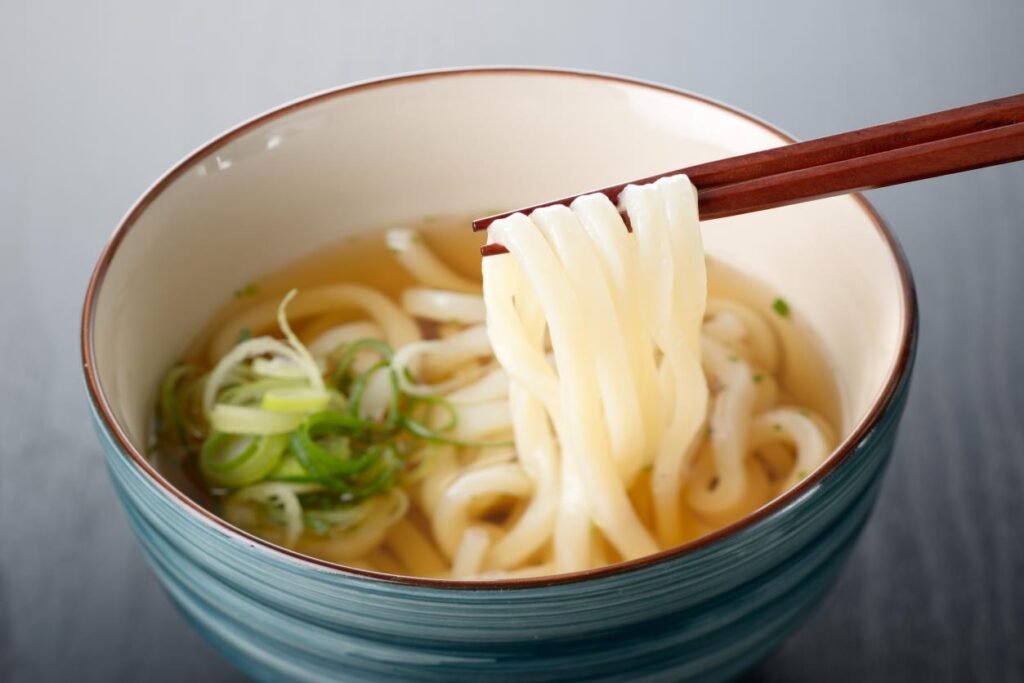
A bowl of (wheat-based) udon noodles in a simple broth reminiscent of the dishes described in the Edo tofu cookbook.
Western influence on Japanese food
Wari shoyu (soy sauce, mirin, sake, etc.) often appears as a seasoning in “100 Tofu Dishes” and was used extensively in warishita (meat stock mixed with soy sauce, mirin, and sugar) in interesting new recipes after the Meiji Restoration (from 1868).
Meat consumption had been banned in Japan for many centuries, but the ban was officially lifted with the Meiji Restoration. Many forward-looking Japanese took this opportunity to open Western restaurants. However, customers were rather resistant to a menu of steak and vegetables, and could not get used to the rich Western-style seasonings. The ingredients were also expensive, and many restaurants were unable to stay in business for long. However, the government believed that if Japan did not Westernize it would not be able to compete equally with Western countries, so it promoted Westernization and included food culture as part of this goal. In 1872, the government attempted to reduce resistance to eating meat by informing the public that Emperor Meiji enjoyed eating meat dishes for nourishment. The Foreign Ministry also decided to introduce French food for its dining rooms, and actively tried to encourage people to eat Western food.
Around this time, Japanese chefs created a new dish by combining beef, which was symbolic of Western cooking, with seasonings popular in the Edo period. The new dish was a kind of beef hotpot called sukiyaki, which used soy sauce, mirin, and sake for seasoning, and also incorporated Japanese ingredients such as tofu and konnyaku. Having been accustomed to the taste of soy sauce since the mid-Edo period, Japanese people liked sukiyaki and it became a big hit.
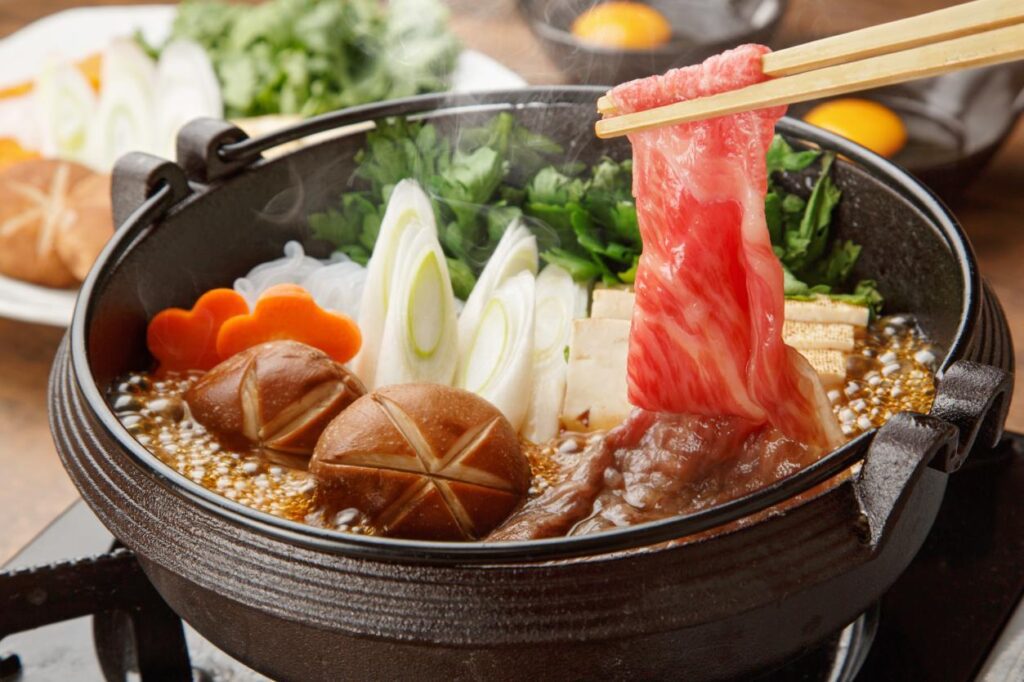
Sukiyaki – a popular dish cooked at the table that contains both meat and tofu and typical Japanese seasonings based on soy sauce and mirin.
Soybeans as an essential ingredient in the Japanese super diet
Researchers at Tohoku University have published a report revealing which period during the post-war recovery saw the most nutritionally balanced Japanese diet.
They found that the typical diet from 1975 was the healthiest. This has been called the “Japanese super diet”.
The diet from 1960 until the mid-70s tended to include fewer side dishes and had a higher salt content, whereas the diet after 2000 tended to be overly Westernized, with more meat and higher fat content.
In contrast, the 1975 diet included more soybeans, was well-balanced with high-quality protein such as eggs, and made skillful use of dashi so that less salt was needed. A further merit to this diet was the consumption of a greater range of foods due to the increasing variety of both Japanese and Western foods.
Around 1975, following the Tokyo Olympics of 1964 and the 1970 World Exposition in Osaka, Western food began to influence Japanese home-cooking, leading to a trend toward Japanese food with a slightly Westernized flavor. With the increased variety of ingredients and the on-going Westernization of food, many new and more convenient Japanese seasoning products also begun to appear in the shops, such as powdered Japanese dashi and miso for home use. This made using dashi and fermented seasonings at home much easier. Despite the great waves of Westernization that followed the Meiji Restoration and post-war period, it is clear that Japanese eating habits retained a good balance of Japanese elements.
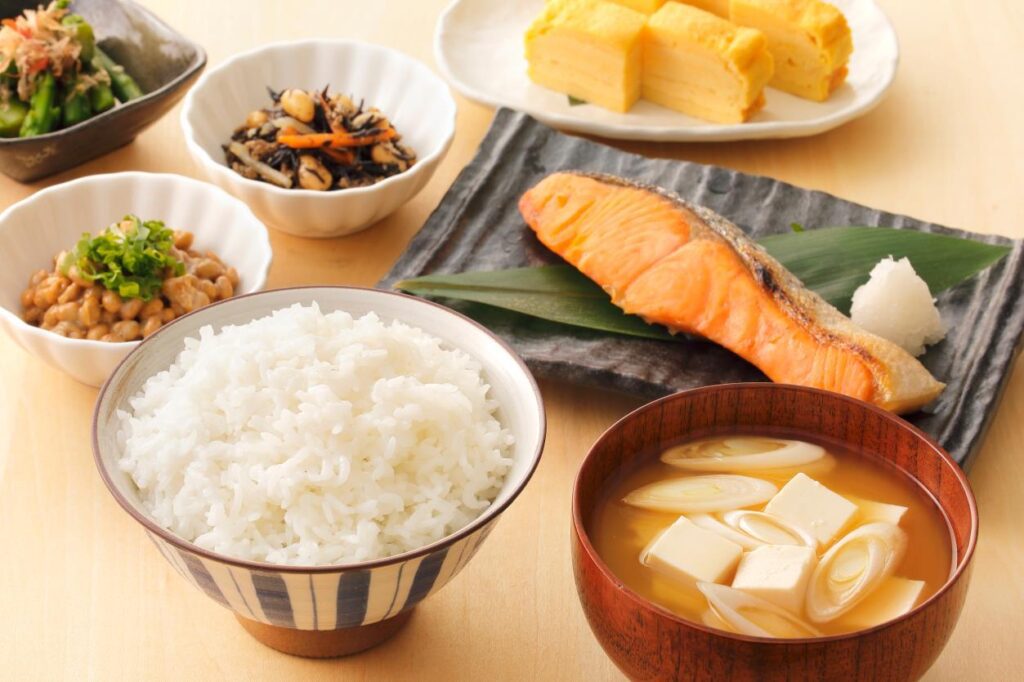
A typical Japanese meal with miso soup containing tofu, natto (fermented soy beans), a simmered dish containing hijiki seaweed and soy beans along with fish and eggs.
From China and Asia to Europe and the Americas
Until the beginning of the 20th century, only China, Korea, and Japan grew soybeans on a large scale in. Europe saw small-scale production in Austria, Romania and Bulgaria, but larger scale cultivation was not carried out because imports were sufficient to meet demand at that time. In the United States, farmers in North Carolina began cultivating soybeans during World War I, and found them to be more resistant to damage from drought and humidity than cowpeas and corn, so soybean production expanded from 1919 onward. After World War II, soybean became the world’s number one crop in terms of production and export volumes. Later, Brazil began cultivating soybean, and is now one of the leading producers along with the United States and Argentina.
Outside of Japan, soybeans have mainly been used for non-food purposes, but with the recent boom in Japanese food, the consumption of tofu and soy milk has grown in Europe and the United States, and soy milk is now on the menus of major global cafe chains and is consumed in ever greater quantities.
Soy-based food products have also gained attention in recent years outside of Asia as good plant-based sources of protein, either as traditional Asian-style foods such as tofu or as an ingredient in more Westernized foods such as plant-based meat products such as burgers.
This highly versatile bean has contributed a lot to Japanese cuisine, and as it is a good source of protein, has a pleasant flavour and is suited to many types of food processing, it is expected that soy beans will contribute to the global transition from a reliance on animal protein to a more balanced diet that includes plant protein.
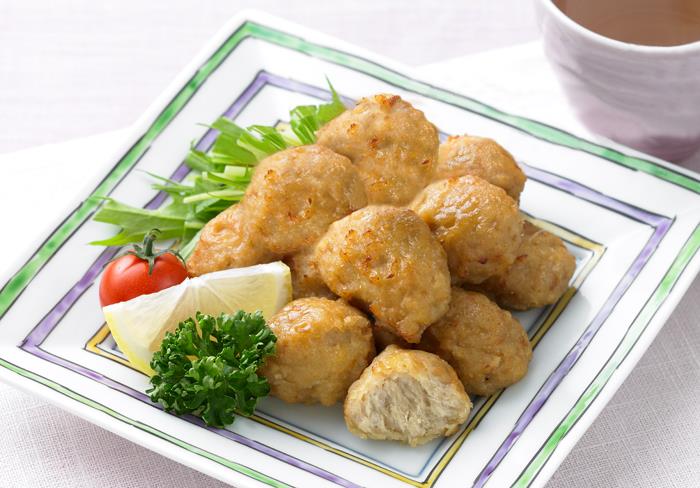
Plant-based chicken nuggets using soy protein instead of meat.
This is part 3 of a series looking at the history of soy that was prepared and previously published by Fuji Oil Japan Ltd.
Missed part 2?
Take a look at this article: “Soybean agriculture and processing in ancient Japan”.
